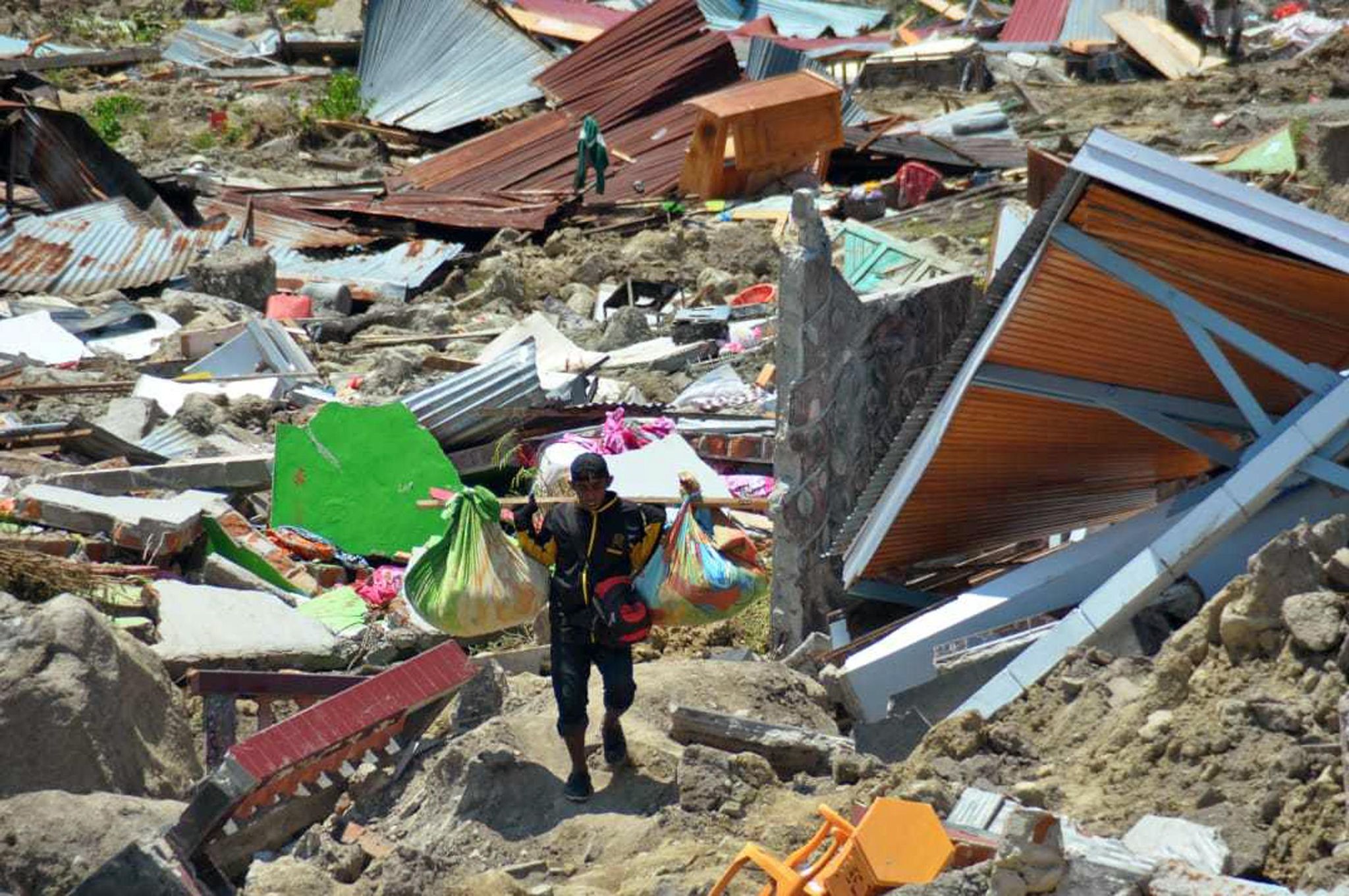
Desperation exploded into anger four days after an earthquake and tsunami decimated parts of the central Indonesian island of Sulawesi, leaving hungry residents grabbing food from damaged stores on Tu
PALU, Indonesia (AP) — Desperation exploded into anger four days after an earthquake and tsunami decimated parts of the central Indonesian island of Sulawesi, leaving hungry residents grabbing food from damaged stores on Tuesday and begging the president for help. The confirmed toll exceeded 1,200 dead with hundreds severely injured and still more trapped in debris.
Most of the attention of rescuers so far has focused on the biggest affected city, Palu, which has 380,000 people and suffered considerable damage. Other hard-hit areas have been largely cut off due to impassable roads and downed power and phone lines after the magnitude 7.5 earthquake struck Friday and generated a tsunami said to have been as high as 6 meters (nearly 20 feet) in places.
“We feel like we are stepchildren here because all the help is going to Palu,” said Mohamad Taufik, 38, from the area of Donggala, who said five of his relatives are still missing. “There are many young children here who are hungry and sick, but there is no milk or medicine.”
The death toll for all affected areas reached 1,234, national disaster agency spokesman Sutopo Purwo Nugroho said in Jakarta. More people remain trapped in Sigi and Balaroa, meaning the toll is likely to rise.
“With all the logistical aid coming in, the service to the refugees is better,” Nugroho said. “We still need more time to take care of all the problems.”
He said 153 bodies were buried Monday in a mass grave and the operation continued Tuesday.
A special aircraft carrying 12,000 liters (3,170 gallons) of fuel had arrived and trucks with food were on the way with police escorts to guard against looters. Nugroho said many gas stations were inoperable either because of quake damage or from people stealing fuel.
In Donggala, the frustration of waiting for days without help boiled over for some.
“Pay attention to Donggala, Mr. Jokowi. Pay attention to Donggala,” yelled one resident in a video broadcast on local television, referring to President Joko “Jokowi” Widodo and the lack of aid reaching his town. “There are still a lot of unattended villages here.”
The town’s administrative head, Kasman Lassa, all but gave residents permission to take food – but nothing else – from shops.
“Everyone is hungry and they want to eat after several days of not eating,” Lassa said on local TV. “We have anticipated it by providing food, rice, but it was not enough. There are many people here. So, on this issue, we cannot pressure them to hold much longer.”
Desperation was visible in Palu as well. Signs propped along roads read “We Need Food” and “We Need Support,” while children begged for cash in the streets and long lines of cars snarled traffic as people waited for gas.
Teams were searching for trapped survivors under destroyed homes and buildings, including a collapsed eight-story hotel in the city, but they needed more heavy equipment to clear the rubble. Nearly 62,000 people have been displaced from their homes, Nugroho said.
Many people were believed trapped under shattered houses in Balaroa, where the earthquake caused the ground to heave up and down violently.
“I and about 50 other people in Balaroa were able to save ourselves by riding on a mound of soil which was getting higher and higher,” resident Siti Hajat told MetroTV, adding her house was destroyed.
In Palu’s Petobo neighborhood, the quake caused loose, wet soil to liquefy, creating a thick, heavy mud that resulted in massive damage. “In Petobo, it is estimated that there are still hundreds of victims buried in mud,” Nugroho said.
Residents who found loved ones – alive and dead – over the weekend there also expressed disgust that it took rescue teams until Monday to reach the area.
President Jokowi authorized the acceptance of international help, Nugroho said Monday, adding that generators, heavy equipment and tents were among the most-needed items. The European Union and about 10 countries have offered assistance, including the United States and China, he said.
Australian Prime Minister Scott Morrison said Tuesday that his government has given $360,000 to help victims and is in talks with Indonesian authorities about a second round of aid. The initial funds are to go to the Indonesian Red Cross for the most obvious emergency aid needs, such as tarpaulins.
Nugroho said only two of the 122 foreigners in the area remained unaccounted for – one from South Korea and the other from Belgium.
The coastline at Palu was strewn with rubble and a few brightly colored cargo containers poking out of the water. Buildings near the water were ruined shells. The arches of a large yellow bridge rested in the water and eerie drone video showed a Ferris wheel, untouched, on a beach scraped bare by the waves.
In Petobo, Edi Setiawan said he and his neighbors rescued children and adults, including a pregnant woman. His sister and father, however, did not survive.
“My sister was found embracing her father,” he said. “My mother was able to survive after struggling against the mud and being rescued by villagers.”
Indonesia is frequently struck by earthquakes, volcanic eruptions and tsunamis because of its location on the “Ring of Fire,” an arc of volcanoes and fault lines in the Pacific Basin. A powerful quake on the island of Lombok killed 505 people in August, and two moderate quakes near an eastern island on Tuesday reportedly damaged a bridge.
The vast archipelago is home to 260 million people on more than 17,000 islands that stretch a distance similar to that between New York and London. Roads and infrastructure are poor in many areas, making access difficult in the best of conditions.
___
Associated Press writers Margie Mason and Ali Kotarumalos in Jakarta, Indonesia, contributed to this report.






